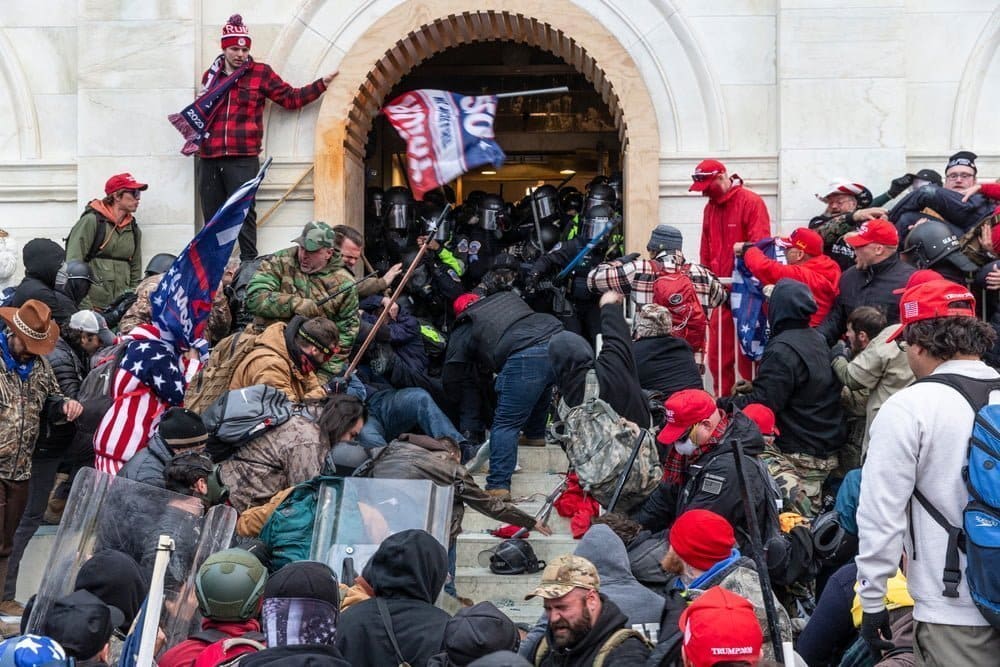Written by Robert Muggah, Pontifícia Universidade Católica do Rio de Janeiro (PUC-Rio)
Political violence is hardly new to America. Since the country’s inception, gunmen have shaped its political landscape, from the Civil War to the Ku Klux Klan, to high-profile assassinations and the bombing of federal buildings. Yet the threat of political violence has deepened in recent years and intensified during the 2024 election cycle. At least 400 distinct incidents of political violence were reported in the first two quarters of 2024, a nearly 80 percent jump from 2022. Targets have ranged from a former president and politicians to election administrators, municipal leaders, school officials and even emergency responders.
The Department of Homeland Security has repeatedly underscored the rising threat of political violence, identifying far-right extremists as the most significant domestic threat to American security. A small number of such groups are rallying on the streets, though many more are active online. In the first half of 2024 alone, nearly one in five local elected officials reported receiving threats. This month, the DHS described the threat of violence linked to the 2024 election cycle as “high”.
Motivated to kill
Political violence is typically defined as the use of physical force to injure a person to advance a political objective. It has surprisingly strong backing in the US: In 2022, roughly one in three American adults felt that political violence was always justified to “protect American democracy”, “save the American way of life”, or to “save the country”. Alarmingly, one in seven Americans strongly agreed with the statement that “in the next few years, there will be civil war in the US.” Although these figures slightly declined by 2023, justification for political violence is disturbingly widespread.
READ: US Voters Concerned About Post-Election Violence and Efforts to Overturn the Results: AP-NORC Poll
Within the US, a persistent undercurrent of conspiracy thinking and apocalyptic belief may increase the risk of political violence. A 2024 study found that around 9% of Americans surveyed in 2022–2023 held a firm belief in QAnon-like narratives, and that US institutions are “controlled by a group of Satan-worshiping pedophiles who run a global sex trafficking operation.” Another 20% of Americans reported “living in what the Bible calls the end of times”. As violent and conspiratorial ideas gain traction, so too the risk that they may be acted out at the hyper-local level.
Armed and ready
The risk of political violence is likewise amplified by the availability of firearms. The US is an outlier when it comes to guns: there are at least 370 million of them in circulation. Between 30 and 40 percent of all Americans claim to personally own at least one firearm. Gun ownership surged in the past decade with surveys showing that over half of US adults lived in a household with a gun in 2023, up from 42 percent in 2013. Intriguingly, the largest increase in gun ownership between 2020 and 2021 appears to have been among liberal and democratic-leaning citizens.
Whether recent purchasers or long-time owners, gun owners typically express higher support for political violence than non gun-owners, with many viewing arms as tools to be mobilized in defense of “American values.” What is more, assault rifle owners and people who regularly seem to be more inclined to see political violence as justified, more willing to engage in it, more willing to kill to advance political objectives, and more willing to organize a violent group.
The same 2024 survey found that among MAGA Republicans, beliefs in potential civil conflict and readiness to bear arms in such a scenario are notably high. Roughly 30 percent of MAGA Republicans strongly believe a civil war is likely in the coming years — three times the rate among non-MAGA Republicans. This diverges from political violence during the 1960s and 1970s, where radical leftist groups were often singled out as the primary actors. Today’s violent potential has largely shifted to the far-right and is more deeply intertwined with gun culture and paramilitary groups.
America’s gun culture and political fragmentation are priming a nation that is already distinctly vulnerable to gun-related violence. In 2021, nearly 49,000 Americans were killed by firearms, with homicide accounting for half of those deaths. Also striking is the role of guns in suicides, accounting for the remaining half of firearm fatalities, which collectively mark the U.S. as a deadly outlier among developed nations. Mass shootings, while accounting for less than 2% of total gun deaths, fuel public concern.
Militias on the march
Private militias, meanwhile, are emboldened. Estimated at 169 active groups today, American militias have a long, turbulent history, reaching prominence in the 1980s and 1990s. By the mid-1990s there were an estimated 859 active militia though their numbers plummeted in the wake of government crackdowns. Since 2016, however, militias such as the Three Percenters and the Oath Keepers have regained momentum, driven by political discontent, anti-immigration rhetoric, and endorsement from far-right political figures. Several of them participated in the “Unite the Right” rally in Charlottesville in 2017 and the “Stop the Steal” activities following the 2020 election, including the Capitol riot, and others continue to mobilize around border security issues.
READ: Rod of Iron Festival in Pennsylvania Still Pushing MAGA Conspiracies, Hate, and Extremism
Federal law prohibits paramilitary activity in all 50 states, yet enforcement is inconsistent, and while some individuals affiliated with militia groups have been charged in recent years, prosecutions are rare. A mix of anti-government sentiment, hyper-local organizing, and the digitally-enabled diffusion of far-right ideologies complicates enforcement, especially in politically charged or rural areas. The Biden administration released the country’s first national strategy to combat domestic terrorism in 2021. Amid mounting evidence of their threat, members of Congress and the Senate proposed the Preventing Private Paramilitary Activity Act to prohibit public “patrolling, drilling, or engaging in harmful paramilitary tactics” in 2024, though the bill has not yet been passed.
Digitally-enabled
Beyond physical confrontations, the online world is another front in the spread of political violence. Social media has revolutionized recruitment and radicalization, with platforms fostering echo chambers where threats, intimidation, and instructions for violence circulate with near impunity. The US Capitol Police investigated over 8,000 threats against Congress members in 2023, reflecting an increase of nearly 50 percent since 2018. Meanwhile, threats to federal judges surged 150 percent from 2019 to 2023. Social media’s economic incentives for engagement drive sensationalism and outrage, often leaving women and minorities particularly vulnerable to harassment.
The anonymity and viral nature of digital spaces introduce new risks. Some militias and extremist groups disguise propaganda under innocuous names, building covert networks to train, organize, and radicalize users. Platforms like Facebook, Telegram, YouTube, X and online gaming communities are in some cases normalizing right-wing extremism, with militias recruiting “active patriots” including current and former law enforcement, military personnel, and disillusioned youth urging them to “stand up” and “be prepared” for civil war. Anti-government sentiment, migrant hostility, and white nationalist messaging often serve as recruitment tools.
The broader implications of American political violence before, during and after the 2024 elections extend well beyond its borders. Perceptions of a weakened or violent American democracy could be geopolitically destabilizing. An election marred by violence could serve as a dog whistle to autocrats and extremists worldwide that democratic processes are vulnerable and potentially embolden similar factions in other countries. Conversely, a peaceful, well-administered election could model democratic resilience, crucial as the world rounds out a record year for national elections in 2024.
The Biden administration’s recent measures to restrict militia activities and enforce penalties for unauthorized military-style drills are a positive step in the right direction. While ambitious, such measures face considerable obstacles, including constitutional concerns over state versus federal powers and strong opposition from Second Amendment advocates. And while increased federal enforcement is essential, heavy-handed policies could backfire, pushing certain groups into further radicalization.
Ultimately, America’s struggle with political violence and domestic extremism underscores the need for a multi-pronged approach, beginning with clearer enforcement of militia laws, responsible gun laws including background checks, red flag laws and an assault rifle ban, and stronger social media regulations and liability for platforms that allow extremist content to circulate. However, these measures require political will and public buy-in, all in short supply in the US’s polarized political landscape.
Even more important, US leaders must re-imagine a constructive political dialogue that rises above tribalism. Beyond law enforcement, addressing political violence means tackling structural inequalities and fostering social cohesion. Measures to bridge ideological divides, strengthen bridging capital, and reduce economic inequality could foster a shared national narrative that undermines violent fringe elements. A generation raised amid political volatility and online radicalization needs constructive engagement in democratic practices and public discourse. As the November 2024 election looms, the stakes are higher than ever. The months to come may prove defining, not only for American democracy but for democracies worldwide.
Robert Muggah is Co-founder of Igarapé Institute and Lecturer at Pontifícia Universidade Católica do Rio de Janeiro (PUC-Rio).
This article is republished from The Conversation under a Creative Commons license. Read the original article.






